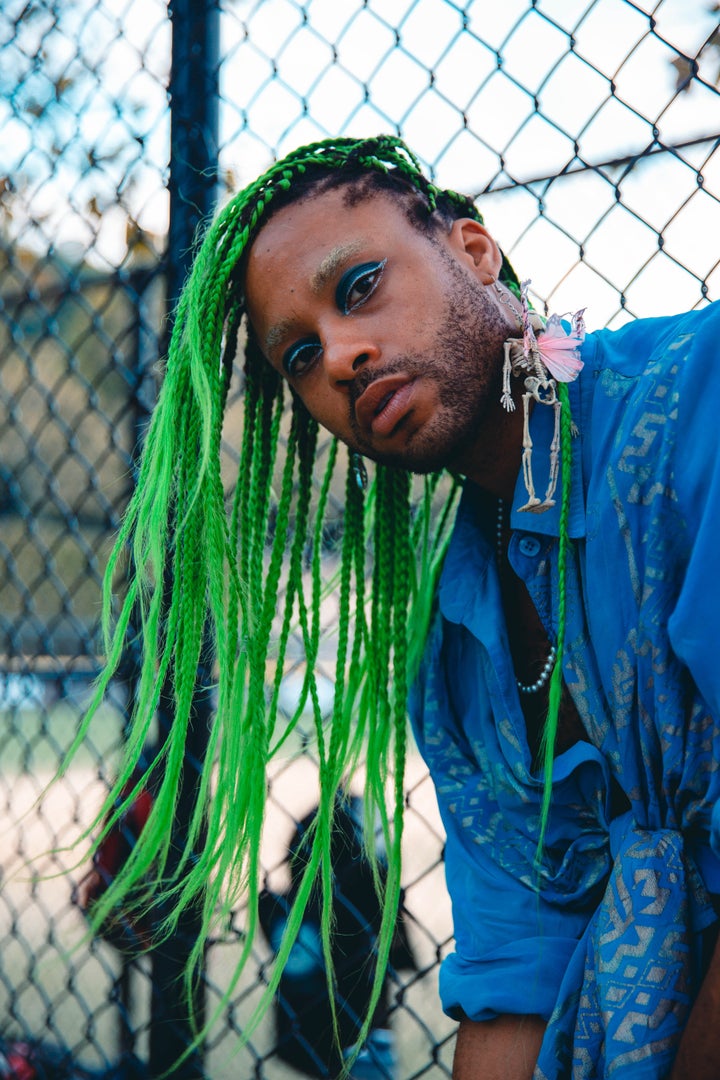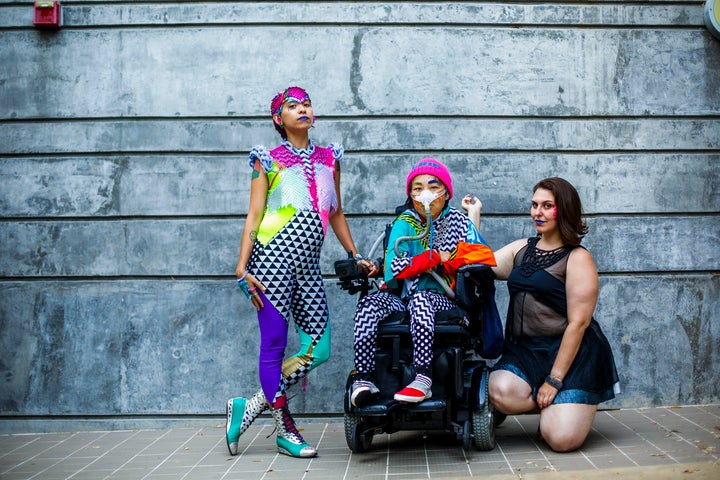As a young actor and LA kid growing up in the entertainment industry, Jordi knew that clothing was powerful. For Jordi, who uses they/them pronouns and only goes by their first name, dressing up onstage allowed them to try on characters and identities they didn’t feel safe to explore at home. “I was able to put on a costume, put on a mask, wear a garment and really be my most authentic self,” Jordi said.
A true theater kid, Jordi was also a big fan of Lady Gaga, and credits part of their aesthetic awakening to a particularly memorable experience attending one of her concerts. “I went with my undies and a trench coat, and then a tie and a dress shirt. I made a statement just being out there and just rocking my own style choices,” Jordi recalled.
Once Jordi left home, their love of bold, experimental clothing only grew. “I became more explorative in how I chose to dress, or was choosing to wear certain things that stereotypically on my body were very new or very rare. That’s when I was able to be seen.” Jordi soon found a queer community who not only appreciated their binary-breaking style, but introduced them to the language of two-spirit identity.
Now a 27-year-old model, designer and consultant with Radimo, a gender-fluid clothing marketplace and inclusion consulting agency, Jordi said fashion has been integral to understanding aspects of their identity. “It was that freedom of my fashion expression that allowed the vocabulary around my own identity to catch up. But if it wasn’t for my fashion, I wouldn’t have been seen in a way that affirmed my identity.”

Like Jordi, many queer people find that fashion can be a powerful form of gender affirmation, a unique signifier of personal identity and a fun, creative way to be visible to other queer people.
Still, being a queer person who wears clothes can be complicated. The perfect ensemble can be a source of pride and creative expression, but sometimes, clothes can become an endless source of frustration, physical discomfort and anxiety.
“I think when I came out in high school, everybody knew, ’cause I was one of the freaky art kids,” said Sky Cubacub, who also uses they/them pronouns. “My parents are both artists, so they always let me dress however I wanted. When I was little, I basically would wear solid pink. I still do, it’s my favorite color. I just love an eye-hurting pink.”
Cubacub also lives with chronic illness, and sometimes struggles to find off-the-rack clothes that are both comfortable and gender-affirming, particularly jeans and undergarments. When Cubacub created Rebirth Garments, they wanted to make gender-affirming undergarments for trans individuals, as well as clothing for people living with physical disabilities.

Cubacub loves clothes, and loves being queer, but finding the right clothes can be tough. They feel the androgynous, “post-apocalyptic utililatarian” look that characterizes some popular queer fashion lines can be somewhat limiting—especially when it centers around white, androgynous, able-bodied consumers. Though monochrome suits and button-up shirts aren’t for everyone, these sometimes tend to dominate the queer fashion landscape, making it tough for some people to find clothing that truly fits their personal style. “Even though I just always really felt agender my whole life, people used to perceive me as very femme just because of wearing pink,” Cubacub said. “But no, anybody can wear all pink.”
While Cubacub’s fashion confidence seemed to come naturally, finding a unique personal style as a newly out queer person isn’t always easy.
“When I came out in my early 20s, masculinity was kind of the gold standard, and I wasn’t a true queer or a true lesbian if I was dressing in heels or wearing lipstick,” said Anita Dolce Vita, the owner of queer fashion line DapperQ who describes her style as “J.Crew femme.” Coming out — or even just thinking about coming out — can feel scary, and worrying about what to wear as a newly emerged queer person can be just as intimidating. “You should be able to choose what you want to wear, and what makes you feel good, and what affirms your identity,” Dolce Vita said. “If you’re a femme and you’re coming out, maybe you like your style, and coming out doesn’t at all impact the way that you want to dress.”
The great thing about coming out, Dolce Vita said, is being out. “That is such a big undertaking. That’s such a big obstacle. Now you can explore other parts of you that you could draw upon your style inspiration. You can have a deeper and more meaningful relationship with your own personal style.”
This can mean enjoying the freedom to experiment with styles, identities and sexual preferences because they feel good, even if they don’t fit in. “Draw upon inspirations from this newfound freedom and love that you have for yourself,” Dolce Vita added. “That could be inspiration from art and architecture, your favorite musicians. Maybe you’re loving Lizzo right now and loving that body positivity. You want to experiment with some glitter, add more makeup, take some makeup away. Whatever it is, now is the time to look for inspiration from the world around you. Because your eyes are now open to who you really are.”
According to Kelliann Denney, assistant merchandizing manager and product engineer at queer clothing retailer Wildfang, comfort is key to finding what works, and what doesn’t. “Find things that feel good against your skin. Find things that you can move in. Find colors that excite you, and really not worry about what everyone else is doing,” Denney told HuffPost. “If you’re not feeling good on the outside, it’s very challenging to feel good on the inside.”
Looking to others for inspiration can be helpful, but certain cuts, colors and trends won’t feel good on everyone, and that’s OK.
“One of the most violent things that we can do to ourselves is compare ourselves to other people. Whether you’re queer, trans, femme, bi,” Denney said, “don’t compare yourself to anyone.”
“You can literally wear anything if you’re queer,” Cubacub added. “It doesn’t matter what you wear, you don’t have to justify your clothing choices. Everybody has their own personal style, and I don’t believe that you have to dress a certain way to be queer.”

